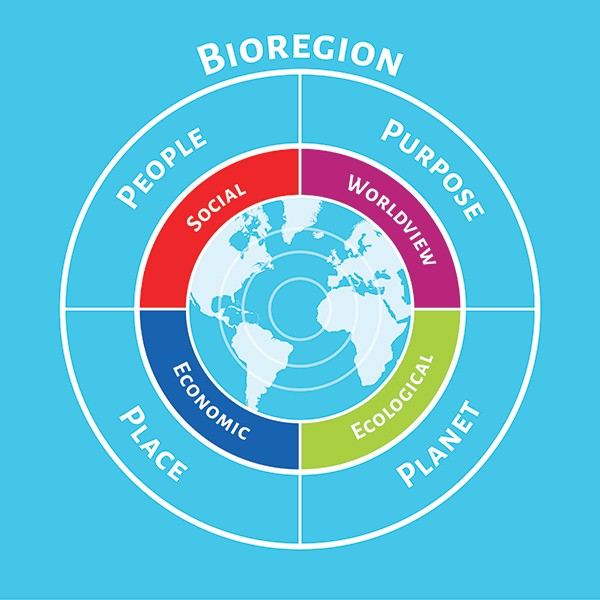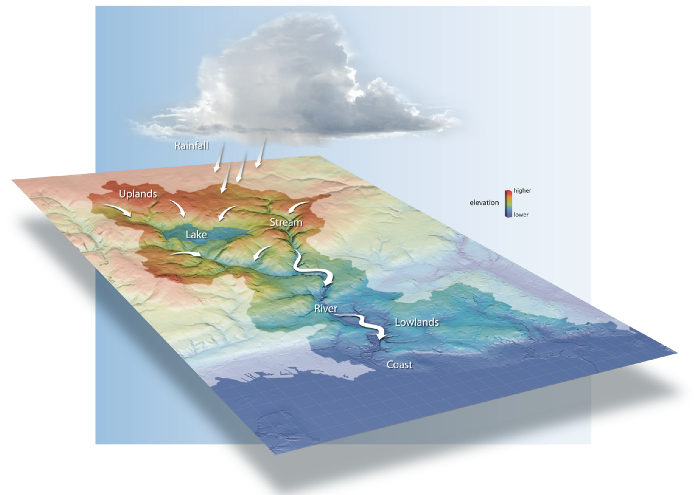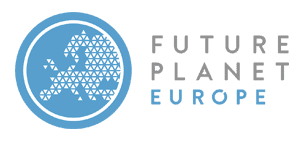Excerpt from the ‘Social Dimension’ of Gaia Education’s online course in ‘Design for Sustainability’
A growing number of people are recognizing that in order to secure the clean air, water and food that we need to healthfully survive, we have to become guardians of the places where we live.
First Continental Bioregional Congress
People sense the loss in not knowing our neighbours and natural surroundings, and are discovering that the best way to take care of ourselves and to get to know our neighbours, is to protect and restore our region.
Building community is one of the most crucial tasks that every group, every intentional or local community should undertake to enable the collective being that animates it to express itself with all its power in a rich and transforming vision. The question now is: where does the community process end?
Does it end with our own group and from there we confront other groups and compete with them for resources, knowledge, or an even more dominant position in the market, in the society, and in the world? Certainly not!
While many early ecovillage projects saw themselves as ‘lifeboats’ of a civilizational shipwreck, almost all of them have understood how impossible this scenario would be. Either we create sustainable, thriving, and regenerative future for all, where nobody is left behind, or we will not succeed as a species in the planetary era.
Most mature ecovillages in many parts of the world have over the last two decades developed extensive outreach projects to their local regions, have learned to speak the language and build partnerships with their regional and national governments and through the Global Ecovillage Network have even become a consultative influence as an NGO reporting into and supporting the United Nations process.
Jonathan Dawson, former president of GEN, has offered a new metaphor for ecovillages, from lifeboats to “yogurt culture”, transforming the milk or their regions into nutritious yogurt. Another way of expressing this is ecovillage and sustainable community culture spreads like a health-generating virus. Regenerative culture change initiatives spread infectious health.
It is impossible to create or sustain a ‘sustainable community’ in isolation. Many of the synergies and win-win design solutions that define regenerative cultures can only happen at the regional scale. So we need to start with sustainable communities but the process begins and does not end there.
Eventually when our group is formed and effective in its collaboration we need to expand our community vision beyond our own group, seeking ways to connect with other groups in our regional and/or global networks — including those groups that are usually under-represented like minority groups or non-human species.
We need to expand our spatial horizons from the local, to the regional and to the global and weave the networks of collaboration. Our work will also deepen by expanding our temporal horizons to those that have come before us (our ancestors and traditional wisdom cultures) who have left a lasting mark in a variety of small things that enrich our current lives and who’s traditional wisdom might hold part of the key to a regenerative and thriving future. In becoming conscious of who we are working for, less for ourselves and more for the future yet unborn generations we are reconnecting with the ancient wisdom of how to live wisely on this Earth.
Every group project that wants to be really sustainable, and strives to strengthen with its vision the Web of Life, should consider these two important dimensions of sustainability:
- A horizontal dimension where we create living networks with other groups, other projects, and other communities in our local, regional, and/or global environment; and
- A vertical dimension where we acknowledge our vital connection with history, with all living beings that were here before us, and with all living beings that will be here after us.
In the design framework that supports Gaia Education’s approach to design for sustainability we call this awareness and conscious co-creation across multiple spatial scales (local, regional, global) and temporal scales (the distant past, the present, and the future) scale-linking design.

While we are engaging in sustainable community design to take a stance and offer practical solutions in the transition towards a sustainable human presence on Earth — creating a sustainable world for all — many of the patterns and processes we need to create in the transition towards increased resilience and sustainability cannot be created at the scale of a small human community of a few dozen or a few hundred people, they will require collaboration between such communities to create these patterns at the scale of their local bioregions.

Just like the ecovillage culture has changed its metaphor from ‘life-boats’ to transformative ‘yogurt culture’, most sustainable community and ecovillage initiatives have understood that to chase the dream of complete and isolated ‘self-sufficiency’ — that was so popular among the hippies of the 1970s — is a mistaken and impossible goal. In many ways this goal goes hand in hand with the story of separation and ‘life-boat’ thinking.
As we step into the cultural narrative of the story of interbeing and recognize our regional, national and global interdependence, we are learning to design and build scale-linked structures of increased local and regional ‘self-reliance’ aiming to meet basic needs within thriving regional economies that are elegantly adapted to the bio-cultural opportunities and challenges of our particular region.
A sustainable human civilization will emerge from the collaboration of diverse and regionally adapted regenerative cultures. These cultures will have a certain level of regional self-reliance with regard to basic needs like food, energy, education, health care and material goods. Their material cultures will be primarily but not exclusively based on regional production for regional consumption enabled by renewable-energy driven, circular economies that use regenerative regional bio-productivity rather than fossil materials and fuels as their resource base.
Life is structured as networks within networks linking across scales. Likewise a sustainable human presence on Earth will emerge from collaborative networks of communities within bioregional, national and global networks of collaboration.
Original article published on 2nd October, 2017
Image by Elena Mozhvilo


Community Discussion
Click here to start the discussion of this article.